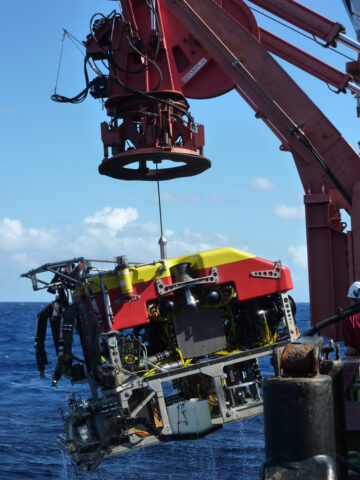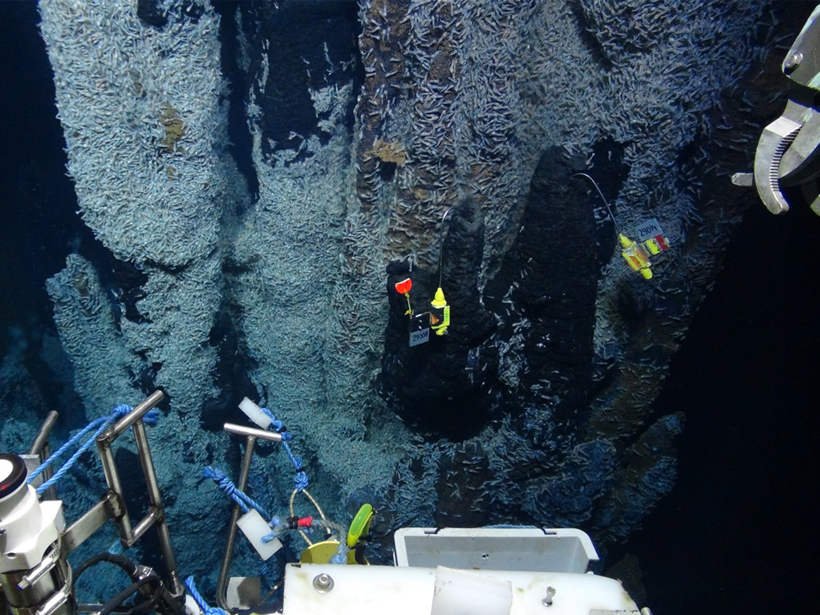The discovery could alter our understanding of geological and chemical processes at the bottom of the sea.
With the 1977 observation of ocean-floor fissures spouting scalding water near the Galápagos Islands off the coast of Ecuador, scientists first revealed a world of hydrothermal vents that form where tectonic plates diverge. These vents teem with bizarre marine life and emit sulfurous black smoke from chimney-like mineral deposits. Now researchers report another type of hydrothermal vent with properties unlike any seen before. The finders of this novel sort of vent say the discovery could alter our understanding of geological and chemical processes at the bottom of the sea.
Vent systems typically flank mid-ocean ridges, chains of mountains formed along tectonic plate boundaries where new seafloor forms as the crust pulls apart. But the new vents discovered at the Von Damm Vent Field (VDVF) near the Mid-Cayman Rise in the Caribbean Sea differ in just about every way from familiar “black smokers,” according to a recent study published in Nature Communications.
“The usual way of thinking is that all the heat is on the axis where the magma is and where there’s eruptions on the seafloor, and that once you get off it you lose that heat source,” says Bill Chadwick, a research professor who studies hydrothermal vents at Oregon State University’s Hatfield Marine Science Center in Newport, Oreg., and was not involved with the study. “But this is suggesting that maybe that’s not true.”
An Unprecedented Precipitate
The VDVF vents pump out fluids at 215°C from 2-million-year-old crust about 13 kilometers from the axis of the slow-spreading ridge. Although cooler than black smokers, which emit 350°C–400°C fluids, the new vents rank as extremely hot compared to vents previously found so distant from a rift. They draw their heat from a different basement rock than black smokers, acting from ultramafic rock instead of basalt, so the fluid from VDVF vents has a different composition than what’s typically found. Instead of thick black smoke, the new vents emit a pale, hot fluid rich in methane and hydrogen and devoid of metal particles.
“We were really surprised that the vents were made from talc.”
Instead of precipitating sulfide metals like black smokers do, the VDVF vent fluids deposit talc as they cool. “We were really surprised that the vents were made from talc rather than any other minerals that we normally see,” says Rachel Mills, professor of ocean and Earth science at the National Oceanography Centre of the University of Southampton in the U.K. “The majority of the mineral phase making up the venting structure is the mineral talc with a bit of amorphous silica. We’ve just never seen this before.”
Fresh Takes on Old Processes

A research team led by Bramley Murton from the National Oceanography Centre in Southhampton discovered the vents in 2010 using deep-sea video. However, the composition of the vents’ fluids and deposits remained unknown until another team (with some of the same members) returned in 2013 to sample fluids, rocks, and fauna with a remotely operated vehicle. Mills says it took so long for anyone to discover the new type of vents because in addition to being far from the axis, they don’t produce the particles that traditional sensors detect.
These hot vents far from the oceanic ridge may yield valuable insights into how the oceanic crust cools, members of the research team said. Scientists had suspected that the crust continues cooling farther from the ridge, but no one had ever found off-axis sources of extreme heat entering the ocean. The new vents also mark a previously unknown source of calcium, magnesium, and carbon dioxide, which could alter models of how the ocean’s chemical composition fluctuates over geologic time scales.
“If we’re right and this type of vent is important on slow and ultra-slow spreading ridges, then it will change our understanding of how heat gets out of the crust into the ocean and how the balance of elements and heat are maintained on the planet,” says Mills.
Searching for More
The team plans to continue searching for hydrothermal vents away from the ridge to determine if they are as common as Mills suspects and to unearth their impact on ocean processes. Most of the approximately 300 known vent systems lie on the axis and are “very, very similar to each other,” she says. “Now we’re starting to fill in the jigsaw by finding these more esoteric, more difficult to find, more extreme type of vent systems.”
—Shannon Kelleher, Writer Intern
Correction, 7 January 2016: An earlier version of this article incorrectly identified Bramley Murton’s institution. This article has been updated to state that Murton works for the National Oceanography Centre in Southhampton, U.K.
Citation: Kelleher, S. (2016), Novel vents built from talc found far from mid-ocean rift, Eos, 97, doi:10.1029/2016EO042943. Published on 5 January 2016.
Text © 2016. The authors. CC BY-NC 3.0
Except where otherwise noted, images are subject to copyright. Any reuse without express permission from the copyright owner is prohibited.

